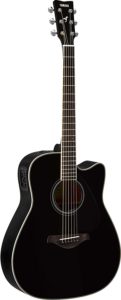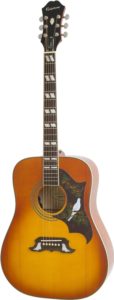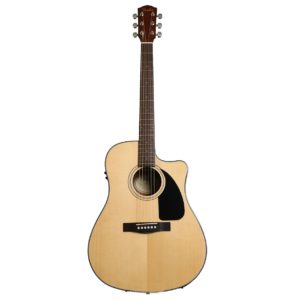Are you looking for the best acoustic-electric guitars? You’re in the right place.

Since piezo pickups were invented, acoustic-electric guitars have become hugely popular – for good reason.
You can enjoy the warm, natural tone of an acoustic guitar and beef up the sound when the moment calls for it.
If you’re looking for ultimate playing flexibility, look no further.
We’re going to show you the best acoustic-electric guitars you can buy for under $500.
Top 3 Best Acoustic-Electric Guitars Under $500:
| Image | Model | Price |
|---|---|---|
 | Yamaha FGX820C Acoustic-Electric Guitar (Editor's Choice) | Check Price |
 | Epiphone DOVE PRO Acoustic-Electric Guitar | Check Price |
 | Fender CD-60CE Acoustic-Electric Guitar | Check Price |
A great guitar is an investment, so always buy the best you can afford, it’ll save you money in the long run. With this guide, you’ll be able to find a quality acoustic-electric guitar under $500 that’ll last you many years to come.
Yamaha FGX820C Acoustic-Electric Guitar (Editor’s Choice)
This dreadnought acoustic-electric from Yamaha’s FG series comes from a long line of folk style guitars. The FGX820C offers the kind of high-quality instrument we’d expect from Yamaha, with a price tag that’s surprisingly low considering what’s on offer.
Build Quality & Design
The Yamaha FGX820C has a solid Sitka spruce top, the right choice for both aesthetics and tone. Sitka spruce is known for its articulate, well-rounded sound and strong projection.
Sitka spruce has become one of the most popular materials for acoustic guitar tops because of these qualities.
Being solid wood, the tone will age nicely, giving even more outstanding tonal balance as time goes on. Yamaha has also made improvements to their scalloped bracing to give the FGX820C even more low-end projection.
Yamaha has chosen mahogany for the back and sides, a popular tonewood known for its well-balanced sound. Mahogany produces a gentle yet full sound, enhancing the mid-range frequencies and clarifying the top end.
Combined with the spruce top, you’ll enjoy a rich, well-rounded tone perfect for vocal accompaniment.
Electronics & Adjustments
The Yamaha System-66 Pickup and preamp electronics translate the spruce and mahogany’s warm tones into a natural amplified sound when it’s time to hit the stage.
There are an under-saddle piezo pickup and an onboard preamp, featuring a 3-band EQ, giving you full control over the bass, mid and treble to help eliminate any feedback. The tuner is easy to use, reliable, and helps to keep your plugged-in sound on point.
Overall
The Yamaha features well-chosen, solid tonewoods, quality electronics, and all the adjustment options you need. Regardless of whether you’re playing an unplugged acoustic performance or you’re amplifying your sound, the FGX820C will deliver a well-balanced, rich tone that far exceeds its price tag.
For under $500, it’s a steal.
Pros
- Made from solid wood, the tones will age and get better with time
- The well-balanced sound across all frequencies
- Three-band EQ
- The preamp does a fantastic job of amplifying the natural, acoustic sound.
Cons
- Despite our best efforts, we couldn’t find a fault with the Yamaha FGX820C. We took to the internet to see what others had to say, and there were no complaints!
Epiphone DOVE PRO Acoustic-Electric Guitar
The Dove Pro is an inexpensive acoustic-electric guitar by the long-time industry legends Epiphone. Solidly built and with a lot to offer, the Dove Pro plays like guitars that cost hundreds of dollars more.
Build Quality & Design
While the guitar doesn’t have solid wood all-around, we do get a solid spruce top. Spruce produces a warm, well-rounded tone that’s a favorite among singer-songwriters.
Maple is the wood of choice for the back and sides, known for producing clean, bright tones. The result is a balanced tone that fits well with any genre of music. The back and sides are laminated, so we don’t quite get the same resonance and rich tones of an entirely solid wood guitar.
As a dreadnought, the Dove Pro is very loud and clear. The bass is low and tight, with excellent mid-range frequencies. Even when playing the Dove Pro unplugged, your audience will hear you just fine.
Electronics & Adjustments
The Dove Pro features Fishman electronics. A Fishman Sonicore pickup is located in the soundhole to capture the spruce and maple’s remarkable resonant qualities, giving you an amplified acoustic tone without any coloration.
The preamp has tone and volume controls for making adjustments on the fly, with a battery life that supposedly lasts up to 100 hours.
We wish everything were a little more easily accessible, significantly when changing the batteries in the preamp.
Overall
The Dove Pro is a well-built guitar with excellent low and midrange tones, although it struggles to compete with the other guitars in this list when it comes to the high frequencies.
Basic adjustment features are enough to maintain a good plugged-in sound, making this super affordable acoustic-electric guitar the perfect instrument for those on a budget, or just starting out.
Pros
- The low price tag makes this a perfect starter instrument
- It plays and feels like a more expensive guitar
- Solid spruce top & laminated maple give a cool, bright tone
- Well concealed preamp and volume/tone controls don’t spoil the classical acoustic guitar look.
Cons
- The battery pack inside the soundhole makes it difficult to access
- Users have reported that high notes can sound a little tinny
- May need a good amount of adjusting out of the box to get your desired sound
Fender CD-60CE Acoustic-Electric Guitar

Fender isn’t particularly well known for venturing into the affordable acoustic guitar market. However, they’ve done just that with the Fender CD60CE.
It’s a solid, no-frills acoustic-electric guitar that provides an excellent foundation for those who want great acoustic sound at a wallet-friendly price.
Build Quality & Design
The back and sides are made from laminated nato – a wood with similar characteristics as mahogany – giving the CD60CE good resonant qualities and a rich tone while allowing Fender to keep the price down.
The top is laminated spruce, giving calm, bright tones, although not entirely on par with solid spruce tops. Being a dreadnought, this guitar has excellent projection and a loud, clear sound.
The cutaway body does change the sound of an acoustic guitar, although having access to those higher frets is worth it, especially for plugged-in performances.
Electronics
Fishman manufacturer some of the finest acoustic guitar pickups on the market, and the CD60CE features the Fishman Isys III system. It does an excellent job of taking the instrument’s great natural tone and amplifying it while still keeping the same remarkable acoustic sound.
There are also a few different options available for tonal shaping. The preamp has a three-band EQ to work with and volume controls, and a tuner, making it easy to maintain a consistently great plugged-in sound for live performances and recording. The Fishman Isys III isn’t the best on the market, but on a $300 guitar, it’s a very capable system.
Overall
For a laminated acoustic-electric guitar, the Fender CD60CE produces a surprisingly robust sound. Well-balanced across the lows, mids, and highs, the dreadnought body gives the instrument excellent projection when unplugged.
The Fishman electronics and onboard adjustments allow you to keep that great sound when plugged in. The CD60CE is a feature-packed, great-sounding guitar at a very respectable price.
Pros
- The cutaway body allows access to higher frets
- Good quality electronics and three-band EQ provide plenty of plugged-in tweaking options
- The well-balanced sound across all frequencies
Cons
- Laminated top, back, and sides don’t provide the same full sound as solid wood guitars. Although the sound is very strong for a laminated guitar, it would benefit massively from a solid wood top.
How to Choose the Best Acoustic-Electric Guitar Under $500
Benefits of Using Acoustic-Electric Guitars
You Get the Best of Both Worlds
The main reason is fairly obvious – electronics. Acoustic-electric guitars are usually just regular acoustic guitars with an onboard pickup and preamp.
You can still get the warm sound of an unplugged acoustic, with the bonus of being able to amplify your sound for live performances and recording.
Guitar-Specific Electronics for Your Acoustic Guitar
Why not just use an aftermarket pickup on your acoustic guitar? You could, but the result generally won’t be as impressive.
The preamp and pickup system on an acoustic-electric guitar was designed specifically for that particular guitar’s body and tone. In contrast, aftermarket systems are a one size fits all product.
Price Is Almost the Same
An acoustic-electric guitar’s price is generally not much more than a regular acoustic, so if you plan to use a pickup or preamp anyway, go for an acoustic-electric.
Disadvantages of Using Acoustic-Electric Guitars
Speaking to people who’ve purchased an acoustic-electric guitar for less than $500, I asked what they wished they knew before deciding to make the purchase.
Things they didn’t consider, which they wish they would have done. These are the two most common things they mentioned:
Poorly Made Acoustic-Electric Guitars Will Disappoint You
Poorly constructed guitars will generally let you down in one (or, if you’re unlucky, both) of the settings.
Buying from cheap manufacturers will usually mean your acoustic-electric guitar will sound greatly unplugged but harsh when plugged in, or it may sound creamy and warm when plugged in but weak when unplugged.
You’re buying an acoustic-electric guitar to enjoy both acoustic and electric settings.
You May Need Extra Equipment
To take advantage of the electric setting on the guitar, you’ll need to consider buying a soundboard. Or, at the very least, an amplifier.
Add to that any extra pedals you may want to buy – volume, tuner, chorus, and delay, and you’ve got a fairly comprehensive list of equipment. If you wanted, you could plug the guitar straight into the soundboard and enjoy that raw acoustic sound.
If the plan was to buy a pickup and preamp for your acoustic guitar, you would be considering the extra equipment anyway.
Technical Aspects of Using Acoustic-Electric Guitars
When you’re buying an acoustic-electric guitar for under $500, it’s essential to know exactly what to look for.
Knowing a good deal from a bad deal will allow you to stretch your budget as far as possible, and you’ll be able to buy the best acoustic-electric guitar for the money.
We’ll cover the main technical aspects to keep in mind when searching for your new instrument.
Onboard Equipment – Preamps, Pickups & Tone Adjustment
That is the whole reason you’re buying an A/E guitar and not adding aftermarket pickups to a regular acoustic.
You want a guitar that can translate the warm, unplugged acoustic sound flawlessly into plugged-in setups. To check the onboard electronics’ quality, look at the preamps, pickups, and tone adjustment.
Piezo-mounted pickups are the most common, and you’ll find them on the bridge of the guitar or under the strings. Soundhole pickups are located – you guessed it – inside the soundhole.
Piezos are considered sharper and more defined, while soundhole pickups translate the warm acoustic sound better. Both provide excellent amplified tone, and it’s down to your taste.
It’s a good idea to look for a guitar with at least some basic adjustment controls on the guitar. Volume and tone adjustments are standard, as well as a tuner.
Some guitars will have onboard EQs, too. You typically won’t need more adjustments, as you can make adjustments at the pedalboard or amplifier.
Onboard adjustments make your life much easier when playing and significantly benefit those with limited amp/pedal setups.
Solid Tonewoods vs. Laminate
In addition to the electronics, you also need to consider the tonewoods of your guitar. Look for the same things you would want in a regular acoustic – solid pine, spruce, mahogany, or other wood known for its resonant qualities.
For extra clarity, maple and cherry are fantastic choices, with koa and cedar being great for a rich, mellower sound. Solid woods provide better tone and resonance when using your guitar unplugged, allowing your guitar’s natural acoustic tone to be amplified more effectively.
Made from layers of wood stacked and glued together, A/E guitars made from laminated wood don’t vibrate as well and therefore don’t produce the full sound of a solid wood model. They are cheaper, making them excellent choices for beginners and those looking for an acoustic-electric guitar on a budget.
Cutaways vs. Full Bodies
For solo performers, guitars with a cutaway neck design are an ideal choice.
The difference can be heard, especially when plugged in, as your audience will be able to hear the small details of intricate fretwork. Cutaways are the most popular design for acoustic-electric guitars for that reason.
Full-body guitars are unmatched for the depth of sound and projection. If you’re a rhythm player or a singer-songwriter, a full-body model would be the best choice for you.
Verdict – Best Acoustic-Electric Guitar Under $500
We’ve shown you some of the best acoustic-electric guitars on the market for less than $500. Accommodating a range of budgets, there’s sure to be one in this list that suits your musical needs!
For us, the Yamaha FGX820C is the clear winner today. It’s the only guitar in this list to have a solid wood top, back, and sides – giving a rich, full tone that will improve with age. In addition to having tonal benefits, solid wood provides strength and durability.
The Yamaha sounds excellent when unplugged, and the onboard electronics provide you with everything you need to give a consistent, powerful plugged-in performance.
The price increase is small when you consider the step up in quality at only $100 more expensive than the other two guitars on this list.